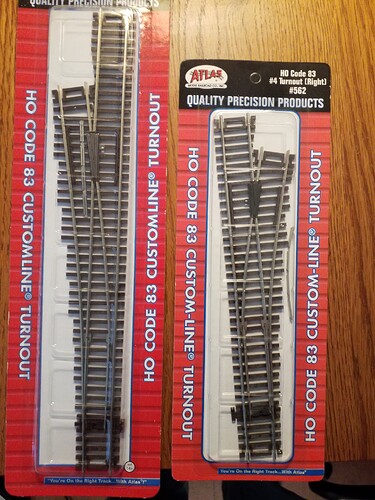There have been multiple threads discussing turnouts recently, may of which have been about Atlas products in particular.
There are some facts about the Atlas turnout products that I feel deserve some clarification, and some explanation of their history.
The first IMORTANT point, the Code 83 Custom Line turnouts need to be discussed separately from the Code 100 Custom Line turnouts. The two lines were developed decades apart, and about the only thing they have completely in common is the track geometry.
I will talk first about the Code 83 line.
Introduced in 1996/97, but not fully available until about 2000, the Code 83 line ALWAYS had the following features:
- Isolated metal frog that can be powered.
- Solid rail points with a hinge system that does not use a rivet like the older Code 100 line.
- Reversible throw bar
- At least “very close” to NMRA frog/flangeway specs.
- Brown ties with more scale size and small nearly scale rail “spikes”.
The Code 83 line did not include the #8 turnout or the curved turnouts when originally introduced. These items were added later.
The #8 turnouts, and the curved turnouts, have packaging that identifies them as “Mark IV”. But to this day, the rest of the Code 83 line has no “Mark” designation on the package or on the companies web site.
The design of the #4, #6, Wye, crossings, etc, in the Code 83 line has not changed since its inception. And despite the “Mark IV” designation, the curved turnouts and the #8’s have the same features and design as the other original Code 83 products.
So, in this regard, the Code 83 line has nothing to do with the early design weaknesses of the Code 100 line, or the various evolutionary steps of the Code 100 line.
The Code 83 line has been since its inception a modeler quality product at an affordable price with a very attractive set of features. It should be judged on its own merits, not on the growing pains of its older brother.
The original Code 100 Custom Line goes back pretty far, late 50’s? I will do some of that research for a follow up.
The Code 100 line has gone thru a series of improvements in that some 70 years, So yes we are up to “Mark V”.
And I am actually going to start my discussion of the the Code 100 line with that newest version.
Several years ago Atlas completely retooled the Code 100 line and brought into complete feature EQUALITY with the Code 83 line, but still with the defining black ties rather than brown.
So these new Code 100 turnouts are now equal to what Code 83 users have been enjoying for 25 years.
Yes, the prior versions of the Code 100 turnouts had some weak points. Originally they had plastic insulated frogs and stamped metal points. The frog dimensions were not NMRA compliant.
Then came the “Mark II” turnout. Metal frogs, “better” points but still with rivet hinges, frog dimensions still not great.
Then in the late 90’s “Mark III”, frogs and point better, still some issues.
About a decade ago, the “Mark IV” Code 100 turnout fixed the issues with the points.
But again, only the recent “Mark V” improvements bring the Code 100 line to a par with the Code 83 line which remains unchanged for over 25 years.
So understand if you are buying used track, or dealing with problems on an older layout, not all Atlas Code 100 turnouts are created equal…
But ALL Atlas Code 83 has been the same modeler grade product since its inception.
So some will ask the question - why did they not make the Code 100 line better sooner? Likely they thought Code 100 might die out. That has not happened.
Sheldon


